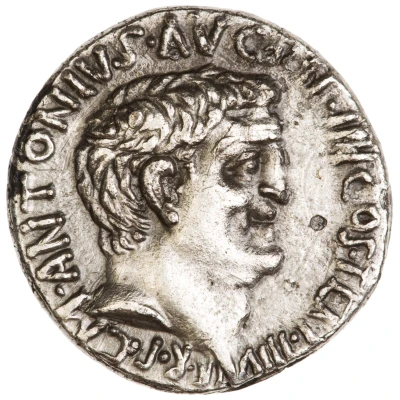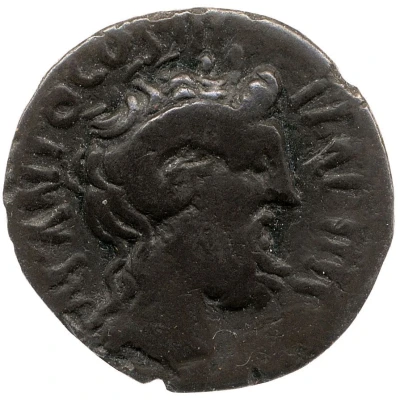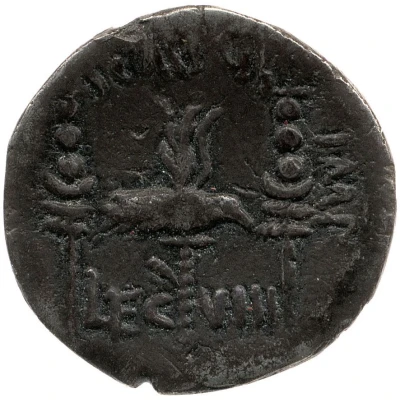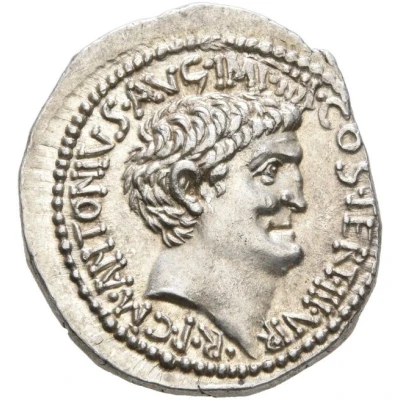
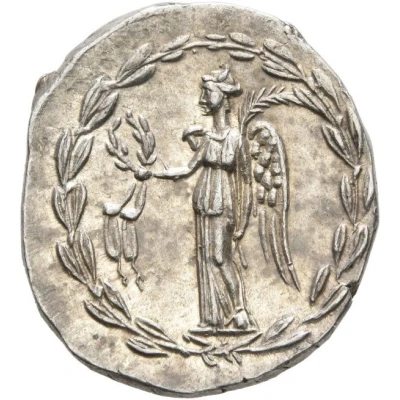

© Leu Numismatik
Denarius - Mark Antony M•ANTONIVS•AVG•IMP•IIII•COS•TERT•III•VIR•R•P•C 31 BC
31 BC year| Silver | 3.87 g | 19 mm |
| Issuer | Rome › Roman Republic (509 BC - 27 BC) |
|---|---|
| Period | Republic (509 BC - 27 BC) |
| Triumvir | Mark Antony (Marcus Antonius) (43 BC - 32 BC) |
| Type | Standard circulation coin |
| Year | 31 BC |
| Value | Denarius (1) |
| Currency | Denarius of 16 Asses (141 – 27 BC) |
| Composition | Silver |
| Weight | 3.87 g |
| Diameter | 19 mm |
| Shape | Round (irregular) |
| Technique | Hammered |
| Orientation | Variable alignment ↺ |
| Demonetized | Yes |
| Updated | 2024-10-06 |
| Numista | N#384694 |
|---|---|
| Rarity index | 100% |
Reverse
Victory standing left, holding wreath tied with fillet in right hand and palm-branch over left shoulder with left hand. Laurel-wreath as border.
Comment
Mass varies: 2.79–3.87 g;Diameter varies: 17–20 mm;
Struck right before Mark Antony's and Cleopatra's dreams of world domination would be utterly crushed under the relentless blows delivered to their galleys by Agrippa's rams in the Battle of Actium on 2 September 31 BC, this wonderful coin feigns an optimism which Mark must have long abandoned at that point. Trapped in swampy terrain at the mouth of the Gulf of Ambrakia after a surprise advance by the forces of Octavian, Antony's massive army and fleet suffered from hunger, disease and desertion throughout the summer of 31 BC. The situation eventually became untenable, forcing him and his beloved queen to attempt a breakthrough through Agrippa's fleet. Their plan was for Antony to engage the opponent so that Cleopatra could slip away with her contingent and the war treasury. Antony would subsequently also break away from Agrippa and reassemble his and Cleopatra's naval and land forces further east to continue the struggle on more solid grounds, with the vast resources of the eastern provinces and Ptolemaic Egypt eventually tipping the scales of the war in their favor.
However, Agrippa's superior generalship and his forces' higher morale and tactical flexibility won him a resounding victory over Antony's fleet, and while the latter successfully fled the scene after transferring from his giant flag ship to a smaller vessel, three-quarters of his fleet was either captured or destroyed. Meanwhile, Cleopatra had successfully sailed to Egypt - a planned tactical withdrawal that would lead to numerous misogynistic accusations of cowardice and treason by ancient and modern writers - but her and her lover's fate was sealed when Antony's demoralized land army capitulated to Octavian shortly after the battle, and most of the eastern client rulers forsook their former master before long. In 30 BC, Octavian's forces entered Egypt, and both Mark Antony and Cleopatra famously committed suicide, bringing to an end the fifteen-year epic struggle that saw Octavian's rise to become the most powerful ruler the world had ever known.
Interesting fact
One interesting fact about this coin is that it features a portrait of Mark Antony, who was one of the most powerful Roman generals and politicians of his time, and later became one of the triumvirs who ruled Rome after the death of Julius Caesar. The coin was minted in 31 BC, during Antony's fourth consulship, and it highlights his title of Imperator, or commander, reflecting his military prowess and influence.
